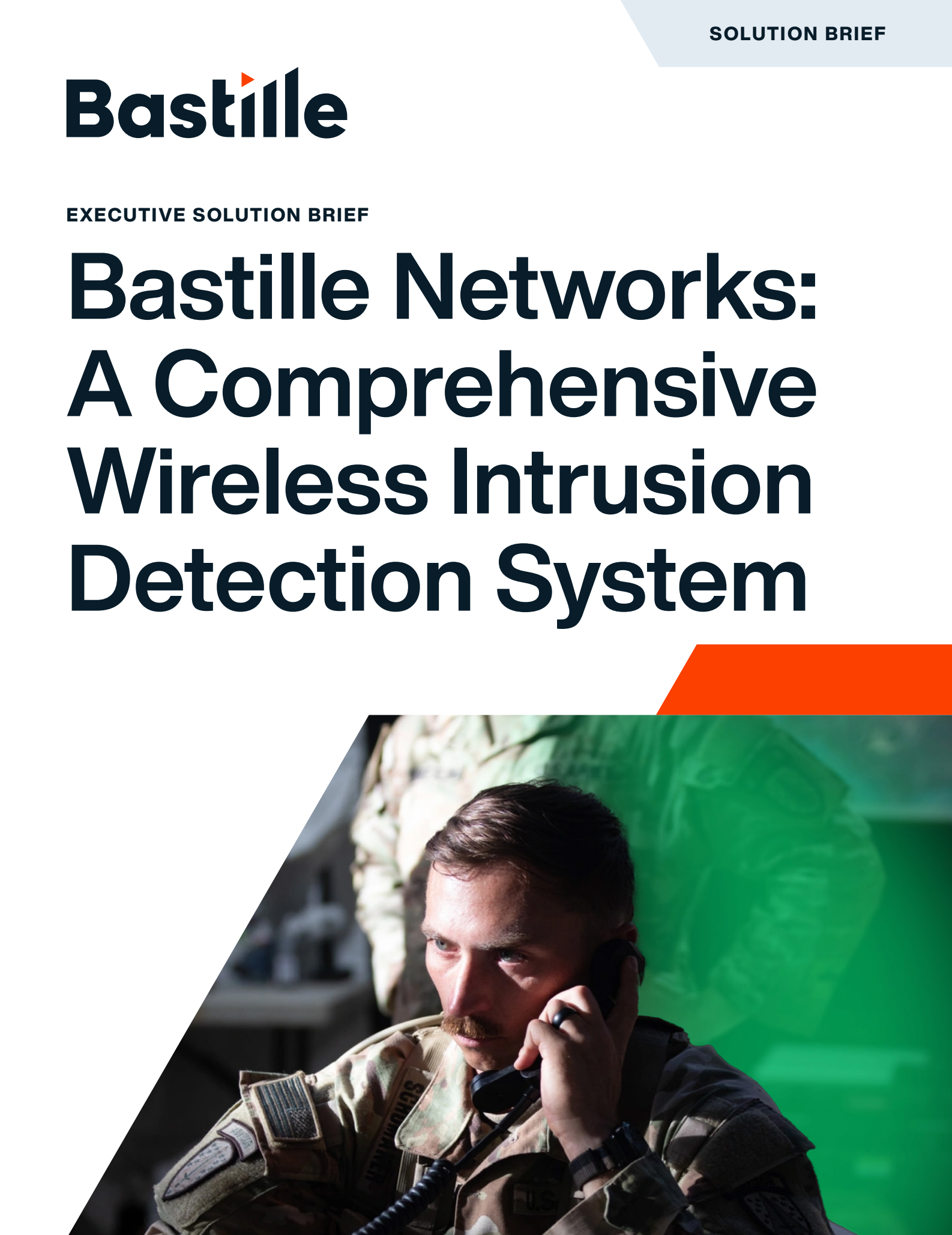
Table of Contents
Wireless Intrusion Detection System (WIDS)
Wireless Intrusion Detection Systems (WIDS) have emerged as essential components in national security infrastructure. These systems monitor the wireless environment for unauthorized or anomalous transmissions.
Government agencies and security-focused enterprises increasingly face stealthy threats that bypass traditional defenses. Due to their ubiquity and accessibility, wireless transmissions are particularly vulnerable. A single unauthorized wireless device operating on the network perimeter can silently exfiltrate data or disrupt operations. WIDS provides real-time detection, continuous airspace monitoring, and forensic visibility to mitigate these threats.
WIDS for Government and DoD Environments
WIDS is vital in maintaining operational integrity and compliance with federal mandates within government and DoD environments. Policies such as DoDI 8500.01, NIST 800-53, and the RMF dictate rigorous monitoring requirements for high-security spaces, particularly SCIFs.
Federal facilities present unique architectural challenges, such as shielded enclosures, zero-trust zones, and wireless prohibition policies. WIDS supports these requirements by operating independently of IT infrastructure, monitoring airspace outside the network, and localizing threat sources to the room or workstation level.
How Wireless Threats Differ from Wired Intrusions
Wireless intrusions can occur without crossing a single physical barrier, unlike wired networks, which require physical access and often leave forensic artifacts. Threat actors can conduct reconnaissance, man-in-the-middle attacks, and credential theft from nearby parking lots or adjacent buildings.
Wireless attacks are characterized by:
- No physical contact: A laptop or mobile device within range is sufficient
- Lack of network visibility: Traditional tools do not see RF activity
- Transient behavior: Devices may appear briefly, conduct an operation, and vanish
WIDS bridges this detection gap by continuously monitoring the RF spectrum for signal anomalies and non-compliant transmissions.
The Rise of Insider Threats in Secure Facilities
Insider threats remain among the most damaging and difficult to detect. In high-security environments, individuals with authorized access can unintentionally or maliciously introduce unauthorized wireless devices. These include:
- Personal hotspots
- Wireless-enabled wearables
- USB dongles with wireless capabilities
WIDS solutions provide persistent monitoring that goes beyond signal detection. They establish RF baselines, recognize behavior anomalies, and correlate wireless activity to known devices and users. This capability allows for rapid containment of insider-originated threats before damage occurs.
Why Traditional Security Measures Aren’t Enough
Conventional cybersecurity tools, such as firewalls, antivirus, or endpoint detection and response, are designed to protect the digital perimeter. However, none of them monitor RF transmissions, which makes them blind to over-the-air threats.
Without WIDS, organizations remain vulnerable to wireless threats, such as:
- Signal leakage: External attackers can capture sensitive data transmitted over wireless
- Unauthorized devices: Personal or malicious APs can appear unnoticed
- Denial-of-service attacks: RF interference can disrupt legitimate wireless operations
WIDS augments traditional security by adding an RF-layer defense that detects threats invisible to standard IT tools.
What Makes WIDS Critical for SCIF Security?
SCIFs are among the most secure environments, intended to protect the highest data classification. Despite their hardened design, they remain susceptible to wireless threats due to:
- Inadvertent device carry-in by staff or contractors
- Signal leakage through structural imperfections
- Advanced attacks designed to evade physical detection
WIDS provides the necessary coverage by:
- Detecting wireless transmissions
- Sending real-time alerts for unauthorized wireless activity
- Integrating with compliance enforcement tools for reporting and audits
This level of visibility supports counterintelligence, security screening, and mission continuity.
How WIDS Complements Physical Security Systems
Physical security systems such as cameras, badge readers, and motion sensors protect against physical breaches. However, these systems cannot detect RF-based threats.
WIDS fills this critical gap by:
- Providing visibility to wireless threats
- Triggering alerts when a user entry corresponds with signal anomalies
- Detecting hidden devices missed by physical screening
The result is a multi-layered defense posture integrating physical and wireless surveillance into one unified framework.
Common Wireless Attack Vectors in Sensitive Environments
| Attack Vector | Threat Description | WIDS Response |
| Evil Twin | Rogue AP imitates facility Wi-Fi | Detects SSID mimicry and correlates device ID |
| Rogue Access Point | Unauthorized AP inside or near the perimeter | Alerts on unknown MAC and RF signature |
| RF Jamming | Signal flooding disrupts services | Detects energy surges in affected bands |
| Wireless-enabled Devices | Cameras, microphones, or hotspots | Detects source and logs duration |
The Cost of Not Having WIDS
The consequences of neglecting wireless detection are severe:
- Breach Response: $4.45 million average cost per incident (IBM 2023)
- Contractual Impact: DoD contractors risk termination
- Mission Delay: Investigations and reauthorization stall projects
- Public Trust: Disclosure of lapses can result in reputational damage
WIDS provides early detection that prevents escalation and preserves operational integrity.
What to Look for in a Top-Tier WIDS Solution
When evaluating WIDS platforms, key differentiators include:
- Zone-Based Detection: Can the system distinguish between adjacent rooms?
- RF Sensitivity: Is the system capable of detecting low-power emissions?
- Passive Operation: Does the system require no active transmission?
- Compliance Frameworks: Are NIST and CNSSI controls fully supported?
- False Alert Mitigation: Can the system suppress non-threat noise effectively?
These features ensure both operational reliability and policy adherence.
Compliance and Regulatory Requirements
Deploying WIDS satisfies several federal directives:
- NIST SP 800-53 (SI-4, PE-20): Continuous monitoring, visitor control
- CNSSI 1253: Explicit requirements for wireless threat detection in classified zones
- Risk Management Framework (RMF): WIDS contributes to risk assessment, mitigation, and ATO justification
Failure to deploy such solutions risks compliance violations, ATO denial, and project setbacks.
Deploying WIDS in Urban vs. Remote Federal Sites
Environmental differences impact WIDS deployment:
- Urban Sites: High-density wireless requires advanced signal filtering and zone differentiation
- Remote Sites: Require autonomous operation, long-range detection, and resilience to environmental interference
Top-tier WIDS platforms must dynamically adjust thresholds, manage overlays, and integrate seamlessly across varied geographies.
How WIDS Supports Zero Trust Frameworks
Zero Trust security assumes the network trusts no device or user inherently. WIDS supports this by:
- Verifying Presence: Confirms physical device existence
- Detecting Unauthorized Wireless Transmissions: Detects rogue wireless devices
- Providing Auditability: Logs every signal for policy review
WIDS extends Zero Trust into the physical and wireless domains, closing the final gap.
Bastille: Federal-Grade WIDS Capabilities
Bastille delivers comprehensive wireless security tailored for government, military, and national security clients:
- 100% Passive Monitoring: Bastille’s FCC-certified solution requires no network access and emits no signal, ideal for SCIFs
- Zone-Based Threat Localization: Identifies threats down to individual rooms or desks
- Wireless-Specific Coverage: Detects rogue APs, client spoofing, and unauthorized device association
- Historical RF Playback: Enables incident reconstruction and audit trails
- DoD-Ready Compliance: Designed to support CNSSI 1253, NIST 800-53, and RMF mandates
Bastille stands out as a purpose-built platform that aligns mission needs with wireless security, bringing visibility to areas once considered undetectable.
Bastille Wireless Awareness: The Missing Layer in the Security Stack
A facility’s wireless environment remains its most overlooked asset. Bastille addresses this gap by:
- Identifying every active transmitter in the vicinity, including Wi-Fi, Bluetooth, cellular, and IoT protocols
- Associating device presence with movement patterns
- Enabling RF zone segmentation for specific access levels
This level of awareness is non-negotiable for modern, classified environments.
Bastille’s RF Signal Mapping and Anomaly Detection
Bastille creates a detection area for wireless activity across a facility. Key elements include:
- Signal Heatmaps: Visual representation of RF signal intensity
- Localization Algorithms: Pinpointing device locations on a floor map
- Historical Baselines: Establishing normal behavior for anomaly detection
Analysts can quickly identify deviations and trace unauthorized activity with forensic accuracy.
Integrating Bastille with Existing SOC Operations
Bastille expands SOC capabilities by adding a wireless dimension to monitoring operations:
- SIEM Platforms: Ingest RF logs and alerts
- SOAR Platforms: Automate playbooks for wireless incidents
- Threat Intel Feeds: Fuse RF data into national or enterprise-level intelligence sharing
These capabilities create a multi-domain situational awareness environment.
Case Insight: Bastille Detection in a Federal Secure Facility
A federal agency operating multiple SCIFs deployed a WIDS platform to validate wireless compliance. During pre-session scans, the system detected a non-approved Bluetooth signal. The security team traced the source to a contractor’s smartwatch, inadvertently carried past physical screening.
Due to real-time alerting and localization, the security team removed the device before any classified discussion began. Subsequently, the agency revised its screening protocols, leveraging Bastille data to reinforce access policies.
Conclusion: A Federal Imperative for Today
Wireless-based threats are real, evolving, and persistent. In the absence of WIDS, secure facilities operate with a critical blind spot. Decision-makers must assess whether their organization has accurate visibility into its airspace.
Those unable to confidently answer “yes” are already behind.
To protect classified data, mission integrity, and national security interests, organizations must:
- Deploy passive, compliant WIDS solutions
- Integrate RF data into SOC workflows
- Establish policies grounded in real-time visibility
The time to act is before an incident, not after. WIDS is not optional. It is foundational.
Your Next Step?
- Evaluate your current wireless visibility.
- Educate your security team about RF risks.
- Explore Top-tier WIDS solutions like Bastille.
- Start small, but start now.
Don’t let an invisible threat become a visible disaster.
Empower your facility. Protect your mission. Secure your spectrum.
FAQs about Wireless Intrusion Detection Systems
What does WIDS detect?
Unauthorized or suspicious Wi-Fi transmissions, rogue APs, and anomalous wireless behavior.
Can WIDS function without network access?
Yes, leading WIDS solutions operate passively, requiring no integration with the network.
Is WIDS a SCIF requirement?
While not explicitly mandated, WIDS deployment supports CNSSI 1253 compliance and enhances SCIF integrity.
Does WIDS replace firewalls?
No. It complements existing tools by securing the airspace they cannot reach.

